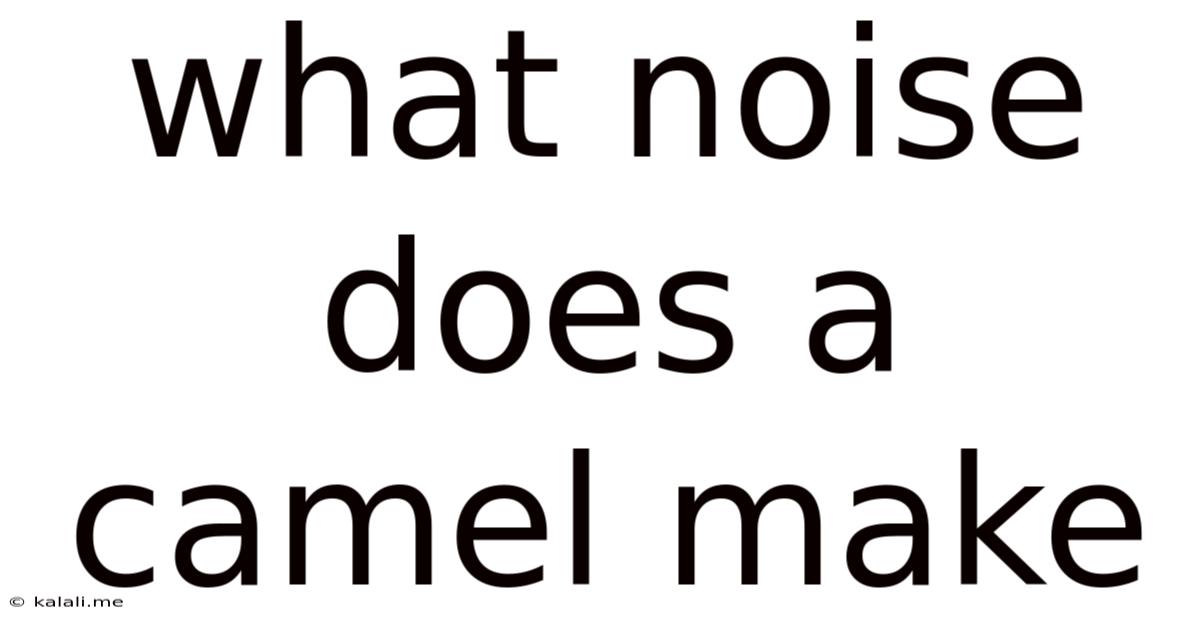What Noise Does A Camel Make
Kalali
Jun 11, 2025 · 3 min read

Table of Contents
What Noise Does a Camel Make? A Deep Dive into Camelid Vocalizations
Camels, those majestic desert dwellers, are more than just humps and endurance. They're surprisingly vocal creatures, and understanding their sounds offers a fascinating glimpse into their social lives and communication strategies. This article explores the various noises camels make, their context, and what they reveal about these incredible animals.
A Variety of Vocalizations: More Than Just a Grunt
Contrary to popular belief, a camel's vocal repertoire is far richer than a simple "grunt." While a low grunt is common, especially in situations of discomfort or mild annoyance, they produce a wide range of sounds depending on their mood and the situation.
The Common Sounds:
-
Grunting: This is perhaps the most familiar camel sound. It can range from a low rumble to a more forceful grunt, often used to express displeasure, warning others, or simply communicating their presence. Think of it as the camel equivalent of a sigh or a low moan.
-
Moaning: A longer, drawn-out sound, often used during periods of distress or when feeling unwell. It's a more plaintive sound than a grunt, carrying a sense of vulnerability.
-
Bellowing: This is a loud, powerful sound reserved for situations of intense excitement, aggression, or alarm. Think of a deep, resonant roar, capable of carrying over long distances. It's often used during mating season or when feeling threatened.
-
Snorting: A sharp, forceful expulsion of air through the nostrils, often accompanied by a head toss. This is a common display of annoyance or warning, similar to a horse snorting.
-
Hissing: A quick, sharp sound made to express aggression or to warn off potential threats. It's usually accompanied by other aggressive behaviors, such as spitting or charging.
Less Common, Yet Equally Important Sounds:
-
Humming: A quieter, less intense sound, often observed in mothers communicating with their young or in social interactions between individuals in a herd. It suggests a sense of comfort and calmness.
-
Clicking: A subtle clicking sound made by camels, often used in short bursts. The precise function of this sound isn't fully understood, but it's thought to be a form of non-vocal communication.
The Context Matters: Decoding Camel Communication
Understanding the context in which a camel produces a particular sound is crucial for interpreting its meaning. The same sound can have different meanings depending on the situation. For example, a grunt might be a simple expression of discomfort in one instance, but a warning in another. Observing the camel's body language – posture, ear position, and tail movements – alongside the sound itself helps to paint a complete picture of their communication.
Factors Influencing Vocalizations:
Several factors can influence the type and frequency of vocalizations in camels:
- Age and Sex: Young camels tend to vocalize more frequently than adults, and males often produce louder, more intense sounds during mating season.
- Social Status: Dominant camels may vocalize more frequently and with greater intensity than subordinate animals.
- Environmental Conditions: Heat, thirst, and other environmental stressors can influence vocalization patterns.
Conclusion:
The sounds made by camels are much more diverse and nuanced than you might initially assume. By understanding the various vocalizations, their contexts, and the factors that influence them, we gain a much deeper appreciation for the complexity of camel communication and their rich social lives. Further research into this area continues to uncover the fascinating secrets of these remarkable animals.
Latest Posts
Latest Posts
-
How Many Pounds Are In 32 Ounces
Jul 01, 2025
-
What Year Would I Be Born If I Was 21
Jul 01, 2025
-
How Many Minutes Are In 40 Hours
Jul 01, 2025
-
How Many Cups Are In 16 Oz Of Sour Cream
Jul 01, 2025
-
How Many Quarters Are In 20 Dollars
Jul 01, 2025
Related Post
Thank you for visiting our website which covers about What Noise Does A Camel Make . We hope the information provided has been useful to you. Feel free to contact us if you have any questions or need further assistance. See you next time and don't miss to bookmark.